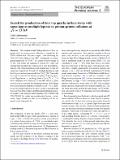Search for production of four top quarks in final states with same-sign or multiple leptons in proton–proton collisions at $$\sqrt{s}=13$$s=13 $$\,\text {TeV}$$TeV
Author(s)
Sirunyan, A. M; Tumasyan, A.; Adam, W.; Ambrogi, F.; Bergauer, T.; Brandstetter, J.; Dragicevic, M.; Erö, J.; Del Valle, A. E; Flechl, M.; Frühwirth, R.; Jeitler, M.; Krammer, N.; Krätschmer, I.; Liko, D.; Madlener, T.; Mikulec, I.; Rad, N.; Schieck, J.; Schöfbeck, R.; ... Show more Show less
Download10052_2019_Article_7593.pdf (1.531Mb)
Publisher with Creative Commons License
Publisher with Creative Commons License
Creative Commons Attribution
Terms of use
Metadata
Show full item recordAbstract
Abstract
The standard model (SM) production of four top quarks ($$\text {t} {}{\overline{\text {t}}} \text {t} {}{\overline{\text {t}}} $$tt¯tt¯) in proton–proton collisions is studied by the CMS Collaboration. The data sample, collected during the 2016–2018 data taking of the LHC, corresponds to an integrated luminosity of 137$$\,\text {fb}^{-1}$$fb-1 at a center-of-mass energy of 13$$\,\text {TeV}$$TeV. The events are required to contain two same-sign charged leptons (electrons or muons) or at least three leptons, and jets. The observed and expected significances for the $$\text {t} {}{\overline{\text {t}}} \text {t} {}{\overline{\text {t}}} $$tt¯tt¯ signal are respectively 2.6 and 2.7 standard deviations, and the $$\text {t} {}{\overline{\text {t}}} \text {t} {}{\overline{\text {t}}} $$tt¯tt¯ cross section is measured to be $$12.6^{+5.8}_{-5.2}\,\text {fb} $$12.6-5.2+5.8fb. The results are used to constrain the Yukawa coupling of the top quark to the Higgs boson, $$y_{\text {t}}$$yt, yielding a limit of $$|y_{\text {t}}/y_{\text {t}}^{\mathrm {SM}} | < 1.7$$|yt/ytSM|<1.7 at $$95\%$$95% confidence level, where $$y_{\text {t}}^{\mathrm {SM}}$$ytSM is the SM value of $$y_{\text {t}}$$yt. They are also used to constrain the oblique parameter of the Higgs boson in an effective field theory framework, $$\hat{H}<0.12$$H^<0.12. Limits are set on the production of a heavy scalar or pseudoscalar boson in Type-II two-Higgs-doublet and simplified dark matter models, with exclusion limits reaching 350–470$$\,\text {GeV}$$GeV and 350–550$$\,\text {GeV}$$GeV for scalar and pseudoscalar bosons, respectively. Upper bounds are also set on couplings of the top quark to new light particles.
Date issued
2020-01-31Department
Massachusetts Institute of Technology. Department of PhysicsPublisher
Springer Berlin Heidelberg
Citation
The European Physical Journal C. 2020 Jan 31;80(2):75
Version: Final published version
